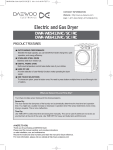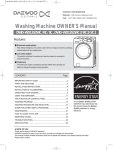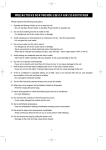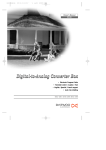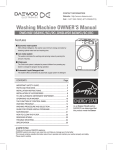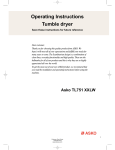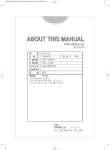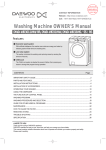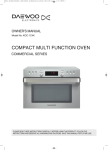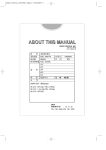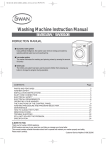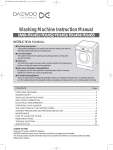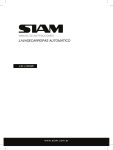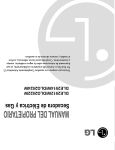Download Daewoo DWR-WG3011RR Specifications
Transcript
CONTACT INFORMATION Website : http://www.e-daewoo.com Call : 1-877-393-7823(1-877-DWESVC3) Electric and Gas Dryer DWR-WE3011WW/RR, DWR-WE31WW, DWR-WE33WS/SS/RR DWR-WG3011WW/RR, DWR-WG31WW, DWR-WG33WS/SS/RR PRODUCT FEATURES " OUTSTANDING PERFORMANCE Besides the large capacity, you can benefit from faster drying time, quiet operation, and energy efficiency. " STAINLESS STEEL DRUM Stainless steel drum resists rust. " DIGITAL FABRIC CARE Multi-Level temperature control takes better care of your clothes. " EASE OF USE An entire selection of user-friendly functions make operating the dryer easier. " ONE TOUCH SELECTIONS To choose an option, press its button once. No need to press buttons multiple times to scroll through a list of options. What are Sensor Dry and Time Dry? Your dryer provides sensor drying and time drying programs. Sensor Dry The dryer senses the dampness of the laundry and automatically determines the heat level and operation time. You might see a sudden increase or decrease in operation time if the sensor determines more or less drying is required. This is not a malfunction. Time Dry Use TIME DRY to select heat level and drying time manually. This can be used if clothes are not as dry as you like them at the end of the cycle. Use TIME DRY for heavy and bulky items and thick work. A NOTE TO YOU Thank you for purchasing a DAEWOO Dryer. Please read this manual carefully, as it provides instructions on safe installation, use, and maintenance Record the model and serial numbers, and retain the manual for future reference. For more information, please visit our website at http://www.e-daewoo.com <http://www.e-daewoo.com/> Ver. 2010 2ND IMPORTANT WARRANTY AND SAFETY INSTRUCTIONS [SEEKING WARRANTY SERVICE] The warranty information for your dryer is located at the end of this manual. Warranty Service is available by contacting the nearest DAEWOO Service Center. If this product is installed and operated according to the instructions in this manual, DAEWOO will repair or replace any parts defective in material or workmanship throughout the warranty period, beginning with the date of purchase. WARNING! For your safety, the recommendations in this manual must be followed. To reduce the risk of fire or explosion, electric shock or to prevent property damage, personal injury, or death when using your appliance follow basic precautions NOTE : These manual should be retained for future reference. Warranty Restriction : If the dryer is subjected to other than single family use, all warranty coverage is effective for only 90 days. You will need the complete model and serial number when requesting warranty service. A proof of purchase is also required. Use the space below to record the model number and serial number of your new DAEWOO dryer. Model Number Serial Number Date of Purchase ❈ Staple your receipt here for convenience when contacting service. WARNING : For your safety the information in this manual must be followed to minimize the risk of fire or explosion or to prevent property damage, personal lnjury or dearth. - Do not store or use gasoline or other flammable vapors and llqulds in the vicinlty of this or any other appllance. - WHAT TO DO IF YOU SMELL GAS • Do not try to light any appliance. • Do not touch any electrical switch; do not use any phone in your building. • Clear the room, building or area of all occupants. • Immediately call your gas supplier from a nel ghbor’s phone. Follow the gas supplier’s Instructions. • If you cannot reach your gas supplier, call the fire department. - Install ation and service must be performed by a qualified lnnstaller, service agency or the gas supplier. FOR YOUR SAFETY Do not store or use gasoline or other flammable vapors and liquids in the vicinity of this or any other appliance. 2 TABLE OF CONTENTS PART 1. SPECIFICATIONS............................................................................................................................3 PART 2. INITIAL STEPS FOR INSTALLING YOUR DRYER........................................................................7 PART 3. ACCESSORIES INSTALLATION ..................................................................................................17 PART 4. ELECTRICAL REQUIREMENTS FOR ELECTRIC DRYER ........................................................18 PART 5. ELECTRICAL REQUIREMENTS FOR GAS DRYERS ................................................................24 PART 6. GAS REQUIREMENTS AND INSTRUCTIONS ............................................................................25 PART 7. USER - MAINTENANCE INSTRUCTIONS ...................................................................................26 PART 8. OPERATING YOUR DRYER .........................................................................................................28 PART 9. TROUBLESHOOTING GUIDE ......................................................................................................35 PART 1 SPECIFICATIONS ■ Type : Electric and Gas Dryer ■ Rating : Please refer to the rating label regarding detailedinformation. ■ Size : 27 x 32.4 x 40.1 inches ■ Capacity : 7.0 cu.ft. IEC, 10.4kg(22.9lb) DWR-WE3011WW/RR 7.3 cu.ft. IEC, 10.4kg(22.9lb) DWR-WE31WW, DWR-WE33WS/SS/RS ■ Weight : 128 Ibs (58.5 kg) ❈ Specifications are subject to change by manufacturer. ■ Accessories Dryer Rack (Option) Pedestal (Option) ❈ Design of pedestals is subject to change without manufacturers notice. 3 Skating Kit (Option) [IMPORTANT SAFETY INSTRUCTIONS] WARNING! To help reduce any risk of electric shock, fire, or other personal injury or property damage when using your Appliance, please exercise care and follow basic safety precautions, including the following: 1) Read all instructions before using the appliance. 2) Do not dry articles that have been previously cleaned in, washed in, soaked in, or spotted with gasoline, drycleaning solvents, or other flammable or explosive substances, as they give off vapours that could ignite or explode. 3) Do not allow children to play on or in the appliance. Close supervision of children is necessary when the appliance is used near children. 4) Before the appliance is removed from service or discarded, remove the door to the drying compartment. 5) Do not reach into the appliance if the drum is moving. 6) Do not install or store this appliance where it will be exposed to the weather. 7) Do not tamper with controls. 8) Do not repair or replace any part of the appliance or attempt any servicing unless specifically recommended in the user-maintenance instructions or in published user-repair instructions that you understand and have the skills to carry out. 9) Do not use heat to dry articles containing foam rubber or similarly textured rubber-like materials. 10) Clean lint screen before or after each load. 11) Keep area around the exhaust opening and adjacent surrounding areas free from the accumulation of lint, dust, and dirt. 12) The interior of the appliance and exhaust duct should be cleaned periodically by qualified service personnel. 13) Do not place items exposed to cooking oils in your dryer. Items contaminated with cooking oils may contribute to a chemical reaction that could cause a load to catch fire. 14) Do not use fabric softners or products to eliminate static unless recommended by the manufacturer of the fabric softner or product. 15) This dryer is designed only for residential use. 16) Ensure pockets are free from small irregularly shaped hard objects, foreign material, etc. ie. coins, knives,pins, etc. These objects could damage your dryer. 17) Do not wash clothing with large buckles, buttons, or other heavy metal or solid decorative things. [SAVE THESE INSTRUCTIONS] USING INSTRUCTIONS 1) Do not overload the drum, that may cause poor drying and wrinkling. 2) Do not over dry fabrics such as knitted fabrics and flannel. 3) Do not dry items such as elastic bands, plastics,rubberized items, or sneakers that might melt or ignite in the dryer. 4) Check the lint filter is in place. 5) Make sure the laundry is not caught when the door is closed to prevent fabric damage. 6) Check the filter every cycle because a clogged filter causes fire hazardous condition and affects the dryer efficiency. 7) When cleaning the surface of the drum, you should use a non-abrasive stainless steel cleaner. 8) To prevent a short circuit or penetrating moisture, make sure the lamp cover is firmly closed. 9) Do not sit on top of the dryer. NOTE: Because of continuing product improvements, Daewoo reserves the right to change specifications without notice. For complete details, see the Installation Instructions packed with your product before selecting cabinetry, making cutouts, or beginning installation. 4 [GROUNDING INSTRUCTIONS] A. For a grounded, cord-connected appliance: This appliance must be grounded. In the event of malfunction or breakdown, grounding will reduce the risk of electric shock by providing a path of least resistance for electric current. This appliance must be equipped with a cord having an equipment-grounding conductor and a grounding plug. The plug must be plugged into an appropriate outlet that is properly installed and grounded in accordance with all local codes and ordinances. WARNING! Improper connection of the equipment grounding conductor can result in a risk of electric shock. Check with a qualified electrician or service representative or personnel if you are in doubt as to whether the appliance is properly grounded. Do not modify the plug provided with the appliance. If it will not fit the outlet, have a proper outlet installed by a qualified electrician. B. For a permanently connected appliance: This appliance must be connected to a grounded metal, permanent wiring system; or an equipment-grounding conductor must be run with the circuit conductors and connected to the equipment-grounding terminal or lead on the appliance. 5 WARNING! To reduce the risk of fire or explosion, electric shock, property damage, personal injury or death when using this appliance, please follow all instructions and information, including those in this manual and instructions provided by your gas supplier. • Do not store or use any gasoline, dry-cleaning solvents other flammable vapors or liquids in the area surrounding this appliance. • Do not dry anything that has or ever had anything flammable on it, even after washing. • No washer can completely remove oil. Do not dry any articles that have or ever had any kind of oil on them, including cooking oil. • Articles containing foam, rubber, rubber-like materials, plastic or similar materials should be air dried. • Failure to follow these instructions can result in fire, death or serious injury. • A qualified service person or company must perform installation and service of this appliance. WARNING! • Keep flammable materials and vapors, such as gasoline, away from the dryer. • Place dryer at least 18 inches above the floor for a garage installation. • Failure to do so can result in death, explosion or fire. California Safe Drinking Water and Toxic Enforcement Act This act requires the governor of California to publish a list of substances known to the state to cause cancer, birth defects or other reproductive harm and requires businesses to warn customers of potential exposure to such substances. Gas appliances can cause minor exposure to four of these substances, namely benzene, carbon monoxide, formaldehyde and soot, caused primarily by the incomplete combustion of natural gas or LP fuels. Properly adjusted dryers will minimize combustion. Exposure to these substances can be minimized further by properly venting the dryer to the outdoors. Do not allow children to play on or in the appliance. Close supervision of children is necessary when the appliance is used near children. 6 PART 2 INITIAL STEPS FOR INSTALLING YOUR DRYER The following instructions will guide you through the initial steps of setting up your dryer. Please note that every section of this manual provides important information regarding the preparation and use of your dryer, and it is important that you review this entire manual before proceeding with any installation or use. More detailed instructions concerning electrical connections, gas connections, and exhaust requirements are provided in other parts of this manual. STEP 1. Positioning the Dryer. Choose a location with a solid floor for your dryer. Place the dryer in the desired location and make sure that it has the required clearances shown below. 44.3" (112.5cm) 40.1" (102.1cm) 27" (68.6cm) 32.4" (82.3cm) NOTE: • Most installations require a minimum 5 1/2(5.5)inches(14cm) clearance behind the dryer for the exhaust vent with elbow. • Leveling legs should be secured. • All four legs should be stably placed on a solid and even floor. • If dryer is not level, laundry may not tumble properly and sensor will not detect humidity information accurately. • When leveling, please be cautious not to injure your fingers and toes. • If you install the dryer on the optional pedestal, it is necessary to level with the pedestal leveling legs. WARNING - Risk Of Fire • Clothes dryer installation must be performed by a qualified installer. • Install the clothes dryer according to the manufacturer’s instructions and local codes. • Do not install a clothes dryer with flexible plastic venting materials. If flexible metal (foil type) duct is installed, it must be of a specific type identified by the appliance manufacturer as suitable for use with clothes dryers. Flexible venting materials are known to collapse, be easily crushed, and trap lint. These conditions will obstruct clothes dryer airflow and increase the risk of fire. • To reduce the risk of severe injury or death, follow all installation instructions. • Save these instructions. 7 Minimum clearances on above, behind, and sides of the unit, as shown below, are required. Those required minimum clearances are set forth in the picture below. Please keep the following instructions in mind when installing in a closet or recessed area: • Consider allowing additional clearance for installation and servicing. • Wall, door and floor molding may necessitate additional clearances. • Additional inches of clearance are recommended to reduce noise while operating. • Consider the space needed for companion appliances. • For closet installations, the picture below shows the minimum required ventilation openings for the door. A louvered door with comparable ventilation openings is also acceptable. 14" max (35.6cm) 18" (45.72cm) ventilation hole ventilation hole 1" (2.54cm) Closet Door 32.4" (82.3cm) Closet Side View 1" (2.54cm) 0" (0cm) 27" (68.6cm) 0" (0cm Closet-Front View Once in position, adjust the leveling legs of the dryer until it is level from left to right and front to back. The leveling legs must remain firmly on the floor and the dryer should not rock. The maximum slope of the dryer from left to right or front to back should not exceed 2.5 cm (1 inch). If the dryer is not level, and if the slope exceeds 2.5 cm (1 inch), a load may not tumble properly and internal sensors may malfunction. NOTE: Other sections of this manual also provide important information concerning the placement of and clearances for your dryer. Please review this entire manual before proceeding with any installation. 8 Installation nstructions Open in position, adjust the leveling legs of the dryer until it is level from left to right and front to back. Be sure to tighten the leveling leg lock nuts against the bottom of the dryer. The leveling legs must remain firmly on the floor and the dryer should not rock. The maximum slope of the dryer from left to right or front to back should not exceed 1”(2.5 cm). If the dryer is not level, and if the slope exceeds 1” (2.5 cm), a load may not tumble properly and internal sensors may malfunction. NOTE: Other sections of this manual also provide important information concerning the placement of and clearances for your dryer. Please review this entire manual before proceeding with any installation. 9 STEP 2. Connecting the Exhaust System WARNING! • To reduce the risk of fire this appliance MUST BE EXHAUSTED OUTDOORS. • The appliance shall not be exhausted into a chimney, a wall, a ceiling, an attic, a crawl space, or a concealed space of a building. • Only rigid or flexible metal duct should be used, for exhausting. • The total length of flexible metal duct shall not exceed 2.4 m. • Do not use plastic or thin foil duct. • Failure to follow these instructions can result in death or fire. • Clean old ducts before installing this dryer. • The exhaust must be vented to the outside. • Improper taping and incorrect installation will cause dryer malfunction. In addition to the following warnings, please refer to manual section on Exhaust Requirements and Maintenance. IMPORTANT: To reduce the risk of fire, combustion, and gas accumulation, the dryer must be vented to the outdoors. Please follow the instructions (and all others in this manual) very carefully. • Foil-type flexible ducts complied with the outline for clothes dryer transition duct, Subject UL 2158A, shall be used. • Do not use plastic or thin foil duct. • Use 4" (10.2 cm) diameter rigid or semi-rigid metal duct (NOTE! Venting materials are not supplied with the dryer, and you should obtain the venting materials necessary for proper installation) • Use the maximum duct length and number of bends refered to "USER-MAINTENANCE INSTRUCTIONS". • Position the dryer such that the exhaust duct run is as short as possible. • The duct shall not be assembled with screws or other fastening means that extend into the duct and catch lint. Clean old ducts before installing this dryer • The male end of each section of exhaust duct must point away from the dryer. • Use as few elbow joints as possible. • Use duct tape on all duct joints. • Insulate ductwork that runs through unheated areas in order to reduce condensation and lint build-up on pipe walls. PLEASE BE AWARE THAT FAILURE TO EXHAUST THE DRYER CORRECTLY WILL VOID THE DRYER’S WARRANTY. Combustible materials, gasoline, and other flammable vapors and liquids must not be stored near the dryer. The dryer must be disconnected from the gas supply piping system during pressure testing at pressures greater than 1/2psi(3.5kPa). The dryer must be exhausted to the outdoors. WHEN DISCARDING OR STORING YOUR OLD CLOTHES DRYER, REMOVE THE DOOR. 10 ■ ALTERNATE EXHAUST DIRECTIONS 1. Remove screw and exhaust duct. 2-1. Detach and remove the knockout that matches the desired venting direction 2-2. Reconnect the new duct[8.66 inch(22cm)] to the blower housing, and fixing the duct to the base. (Right side not available on Gas Dryers) 3-1. Insert the male end of a 4" elbow into the female end of a short duct. Tape the joint. 3-2. Insert this assembly elbow first through the hole in the dryer and push the female end of the elbow onto the male end of the blower output shaft. Tape the joint. 11 STEP 3. Connection of Gas Supply (Gas dryer only). In addition to the following, please refer to manual section on Gas Requirements and Instructions. 1 2 5 3 4 1. New stainless steel flexible connector. Use this type of connector only if allowed by local codes. Use Design AGA Certified Connector. 2. 1/8" NPT Pipe Plug (for checking inlet gas pressure) 3. Equipment Shut-Off Valve Installed within 6’ (1.8 m) of dryer. 4. Iron Pipe. Shorter than 20’ (6.1 m) Use 3/8" pipe. Longer than 20’ (6.1 m) - Use 1/2" pipe. 5. 3/8" N.P.T. Gas Connection. NOTE: Make sure the burner orifice is proper for the type of gas you have. For instance, using LPG with LNG orifice will result in death, fire or explosion. Or using LNG with LPG nozzle will not allow the burner to ignite. If needed, orifice conversion should be done by a qualified service technician and mark or put the label of the current type of orifice on the dryer. If changing the orifice, also adjust the gas valve. 1. Confirm that the type of gas available in your laundry room is appropriate for the dryer. The dryer is prepared for Natural Gas with a 3/8" NPT gas connector. 2. Remove the shipping cap on the gas connector at the back of the dryer. Make sure that you don’t damage the threads of the gas connection pipe when you remove the shipping cap. 3. Connect the dryer to your laundry room’s gas supply using a new flexible stainless steel connector (as noted below, use a new stainless steel flexible connector if allowed by your local codes). 4. Securely tighten all connections between the dryer and your laundry room’s gas supply. Turn on your laundry room’s gas (both supply and check all pipe connections internal and external) for gas leaks with a non-corrosive leak detection fluid. 5. For LP (Liquefied Petroleum) gas connection, refer to this manual’s section entitled Gas Requirements and Instructions. 12 STEP 4. Electrical Plug Connections Following steps are several warnings and instructions concerning making the electrical connection for electric dryers. More detailed information concerning the electrical connection is provided in the manual section entitled Electrical Requirements for Electric Dryer. It is important that you thoroughly review that section and the remainder of this manual, before taking any steps to install or use this dryer. 1. Use only a new UL listed No. 10 (copper wire only) three or four conductor power supply cord kit rated 240 Volts (minimum) 30 Amperes and labeled as suitable for use in a clothes dryer. 2. A four-wire cord is required for manufactured (mobile) home installations and where local codes do not allow grounding of this appliance through neutral. 3. Electrical Plug Connections. 4. For additional instruction on connecting the dryer to an electrical power source, please refer to this manual's section on Electrical Requirements and Electric Dryer. NOTE: Burner input requirements If your house is located at the elevations up to 10,000 feet. Adjusting burner input setting is not required at this elevation because AGA certifies this dryer will not have any problem with the BTU rating at this altitude. If your house is located above 10,000 feet, you are required to adjust a four percent (4%) reduction of the burner BTU rating indicated on the model/serial rating plate. WARNING! • Use a new UL listed 30 amp power supply cord. • Use a UL approved strain relief. • Disconnect power before making electrical connections. • Connect neutral wire (white or center wire) to center terminal. • Ground wire (green or bare wire) must be connected to green ground connector. • Securely tighten all electrical connections • See installation instructions for complete instructions. • Failure to do so may result in fire or electrical shock. 13 STEP 5. Preparation of the Dryer Prior to the first use of this appliance, use all purpose cleaning products or a solution of detergent and water, with damp cloth to remove from the inside of the dryer drum/drying compartment any dust or dirt that may have accumulated inside the dryer. Plug-in your dryer after reviewing the following parts on your dryer’s Electrical Requirements. STEP 6. Confirming Heat Source Operation Confirming Heat Source in Gas Dryers Close the door to the dryer drum/drying compartment and, after completing all steps in this manual for proper installation of this dryer, start the dryer on a heat setting. After the dryer starts, the igniter will glow red and the main burner will ignite. WARNING! If all air is not purged from the gas line, the gas igniter may go off before the gas and the main burner have ignited. If this happens, the igniter will re-attempt gas ignition after approximately two minutes. Confirming Heat Source in Electric Dryers Close the door to the dryer drum/drying compartment and, after completing all steps in this manual for proper installation of this dryer, start the dryer on a heat setting. The exhaust air or the exhaust pipe should be warm after the dryer has been operating for three minutes. STEP 7. Dryer Airflow Effective dryer operation requires appropriate dryer airflow. The adequacy of the airflow can be measured by evaluating the static pressure. Static pressure in the exhaust duct can be measured with a manometer, placed on the exhaust duct approximately 1 ft. (30.5cm) from the final outlet. Static pressure in the exhaust duct should not exceed 7.6mm water column. The dryer should be checked while the dryer is running with no load. Measuring Static pressure Manometer Exhaust Duct MAXIMUM STATIC PRESSURE IN WATER COLUMN 7.6mm 14 STEP 8. Procedure for Reversing the Door The door on your dryer can be installed to open either to the left or the right. Follow these instructions to reverse the direction in which your door opens: Note : Door and latch should be aligned at the center when closed. STEP 9. Additional Instructions for Installation of Your Dryer in a Manufactured or Mobile Home. The following instructions are applicable to installations of the dryer in a manufactured or mobile home. Any installation in a manufactured or mobile home must comply with the Manufactured Home Construction and Safety Standards Title 24 CFR, Part 32-80 or Standard CAN/CSA0Z240 MH and local codes and ordinances. If you are uncertain whether your proposed installation will comply with these standards, please contact a service and installation professional for assistance. (CONTACT INFORMATION : 1-877-393-7823(1-877-DWESVC3) The following instructions apply to any installation of the dryer in a manufactured or mobile home: 1) The electrical connection for an electric dryer must be a 4-wire connection. More detailed information concerning the electrical connection is provided at the manual section entitled Electrical Requirements for Electric Dryer 2) To reduce the risk of combustion and fire, the dryer must be vented to the outside. 3) Electric dryers may be vented to the outside using the back, left, right, or bottom panel. 4) Gas dryers may be vented to the outside using the back, left, or bottom panel. Gas dryers must not be vented to the outside using the right side panel because of the burner housing. 5) The dryer exhaust duct must be affixed securely to the manufactured or mobile home structure, the exhaust duct must be made of a material that will resist fire and combustion, and it is recommended that you use a rigid or flexible metal pipe. 6) DO NOT connect the exhaust duct with any other exhaust duct, vent, or chimney. 7) Make sure the dryer has adequate access to outside fresh air to ensure proper operation. The opening for outside fresh air must be at least 25 in2 (163 cm2). 8) It is important that the clearance of the duct from any combustible construction be at least 2 inches (5 cm), and, when venting the dryer to the outdoors, the dryer can be installed with a clearance of 1 inch at the sides and back of the dryer. 9) Please be aware that venting materials are not supplied with the dryer. You should obtain the venting materials necessary for proper installation. WARNING! DO NOT connect exhaust ducts with metal screws or fasteners that extend into the duct. DO NOT vent the exhaust duct under the manufactured or mobile home. 15 STEP10. Connecting the inlet hose The dryer must be connected to the cold water faucet using the new inlet hoses. Do not use old hoses. 1. If space permits, attach the brass female end of the “Y” connector to the cold water faucet. 2. Turn the cold water faucet off. 3. Attach the straight end of long hose to “Y” connector. 4. Using pliers, tighten the coupling with an additional two-thirds turn. 5. Attach angled end of long hoses to fill the valve at the bottom of the dryer’s rear frame. Screw on coupling by hand until it is seated on fill valve connector. 6. Using pliers, tighten the coupling with an additional two-thirds turn. 7. Check that the water faucets are on. 8. Check for leaks around “Y” connector, faucets and hoses. 16 PART 3 ACCESSORIES INSTALLATION Stacking Kit Installation Instructions(DRYER & PEDESTAL) To ensure safe and secure installation, please observe the instructions below. WARNING! Incorrect Installation can cause serious accidents. The weight of the dryer and the height of installation makes the stacking procedure too risky for one person. This procedure should be performed by 2 or more experienced service personnel. 1) Remove pedestal, installation hardware, and instructions are in the shipping carton. 2) Position dryer on top of the pedestal. NOTE: Because of the weight of the dryer two or more people may be needed. If dryer was previously installed, uninstall it as follows Refer to pedestal installation manual.(Pedestal Model : P-W151) A : Uninstalling an electric dryer: 1 Unplug the power supply cord, 2 Pull the dryer away from the wall enough to loosen the vent clamp. Loosen the clamp and carefully remove the exhaust vent from the dryer exhaust outlet. B : Uninstalling a gas dryer: 1 Shut off gas. 2 Unplug power cord. 3 Disconnect gas line from dryer. 4 Pull away and loosen vent clamp. 5 Disconnect venting. 17 PART 4 ELECTRICAL REQUIREMENTS FOR ELECTRIC DRYERS The following are additional instructions regarding electrical connections and requirements for electric dryers. Important Warning To help prevent fire, electric shock, serious injury or death, the wiring and grounding must conform to the latest edition of the National Electrical Code, ANSI/NFPA 70 and all applicable local regulations. Please contact a qualified electrician to check your home’s wiring and fuses to ensure that your home has adequate electrical power to operate the dryer. 120V/ 240V, 60 Hertz, 3-Wire Installation Instructions for Grounding of your Electric Dryer: a) This dryer must be connected to a grounded metal, permanent wiring system or an equipment-grounding conductor must be run with the circuit conductors and connected to the equipment-grounding terminal or lead on the dryer. b) The dryer has its own terminal block that must be connected to a separate 60 Hertz single phase AC circuit, fused at 30 Amperes (the circuit must be fused on both sides of the line). ELECTRICAL SERVICE FOR THE DRYER SHOULD BE OF MAXIMUM RATE VOLTAGE LISTED ON THE NAMEPLATE. DO NOT CONNECT DRYER TO 110, 115, OR 120 VOLT CIRCUIT. c) If branch circuit to dryer is fifteen feet (4.50 m) or less in length, use U.L. (Underwriters Laboratories) listed No. 10 A.W.G. wire (copper wire only), or as required by local codes. If over fifteen feet (4.50 m), use U.L. (Underwriters Laboratories) listed No. 8 A.W.G. wire (copper wire only), or as required by local codes. Allow sufficient slack in wiring so dryer can be moved from its normal location when necessary. d) The power cord (pigtail) connection between wall receptacle and dryer terminal block IS NOT supplied with dryer. Type of pigtail and gauge of wire must conform to local codes and with instructions mentioned on the following pages. e) The method of wiring the dryer is optional and subject to local code requirements. Refer to examples on next page. f) You must select the method by which to wire your dryer according to local code and ordinance requirements. Sample methods are included in the following pages. 18 Review the following options to determine the appropriate electrical connection for your home: Use the instructions in this section if your home has a 4-wire receptacle (NEMA type 14-30R) and you will be using a UL listed, 120/240 volt minimum, 30 amp, dryer power supply cord. Use the instructions in this section if your home has a 3-wire receptacle (NEMA type 10-30R) and you will be using a UL listed, 120/240 volt minimum, 30 amp, dryer power supply cord. 4-wire receptacle (NEMA type14-30R) 3-wire receptacle (NEMA type10-30R) If this type is available at your home. you will be connecting to a fused disconnect or circuit breaker box. If this type is available at your home. you will be connecting to a fused disconnect or circuit breaker box. 3-wire direct 4-wire direct 19 4-wire connection : Direct wire Important : Grounding through the neutral conductor is prohibited for (1) new branch-circuit installations, (2) mobile homes, (3) recreational vehicles, and (4) areas where local codes prohibit grounding through the neutral conductor. Prepare minimum 5 ft (1.52 m) of length in order for dryer to be replaced. First, peel 5 inches (12.7 cm) of covering material from end. Strip 5 inches of ground wire insulation. After cutting 11/2 inch (3.8 cm) from 3 other wires peel insulation back 1 inch (2.5 cm). Make ends of 3 wires a hook shape. Then, put the hooked shape end of the wire under the screw of the terminal block (hooked end facing to the right) and pinch the hook together and screw tightly. 1. Connect neutral wire (white) of power cord to center terminal block screw. 2. Connect red and black wires to the left and right terminal block screws. 3. Connect ground wire (green) of power cord to external ground screw and move neutral ground wire of appliance and connect it to center screw. 4. Make sure that the strain relief screw is tightened. Be sure that all terminal block nuts are on tight and power cord is in right position. 20 3-wire connection : Direct wire Important : Grounding through the neutral conductor is prohibited for (1) new branch-circuit installations, (2) mobile homes, (3) recreational vehicles, and (4) areas where local codes prohibit grounding through the neutral conductor. Prepare minimum 5 ft (1.52 m) of length in order for dryer to be replaced. First, strip 3 1/2 inches (8.9 cm) of outer sheath from end and strip 1 inch of insulation from each conductor. Then, put the hooked shape end of the wire under the screw of the terminal block (hooked end facing rightward) and pinch the hook together and tighten the screw securely. 1. Connect neutral wire (white) of power cord to center terminal block screw. 2. Connect red and black wires to the left and right terminal block screws. 3. Make sure that the strain relief screw is tightened. Be sure that all terminal block nuts are on tight and power cord is in right position. 21 Option 1: 4-wire connection with a power supply cord. • lf your local codes or ordinances do not allow the use of a 3-wire connection, or you are installing your dryer in a mobile home, you must use a 4-wire connection. 1. Connect neutral wire (white) of power cord to center terminal block screw. 2. Connect red and black wires to the left and right terminal block screws. 3. Connect ground wire (green) of power cord to external ground screw and move neutral ground wire of appliance and connect it to center screw. 4. Make sure that the strain relief screw is tightened. Be sure that all terminal block nuts are on tight and power cord is in right position. 22 Option 2: 3-Wire connection with a power supply cord. lf your local codes or ordinances permit the connection of a frame-grounding conductor to the neutral wire, use these instructions. If your local codes or ordinances do not allow the connection of a frame-grounding conductor to the neutral wire, use the instructions under Section 1: Optional 3- wire connection. Section 1 Option 3: Optional 3-wire connection. • If your local codes or ordinances do not allow the connection of a frame-grounding conductor to the neutral wire, use the instructions under this section. 1. Connect neutral wire (white) of power cord to center terminal block screw. 2. Connect ground wire of appliance and neutral wire of power cord to center terminal block screw. 3. Connect red and black wires to the left and right terminal block screws. 4. Make sure the strain relief screw is tightened. Be sure that all terminal block nuts are on tight and power cord is in right position. 5. Connect independent ground wire from external ground connector to proper ground. 23 PART 5 ELECTRICAL REQUIREMENTS FOR GAS DRYERS 120 Volt, 60 Hertz, with 3-Prong Grounding Plug Following are additional instructions regarding electrical connections and requirements for gas dryers. Important Warning To help prevent fire, electric shock, serious injury or death, the wiring and grounding must conform to the latest edition of the National Electrical Code, ANSI/NFPA 70, or the Canadian Electrical Code, CSA C22.1, and all applicable local regulations. Please contact a qualified electrician to check your home’s wiring and fuses to ensure that your home has adequate electrical power to operate the dryer. Electrical Requirements for Your Dryer: a) Please note that the wiring diagram is provided inside the dryer control hood. Label all wires prior to disconnection when servicing the dryer, because wiring errors can cause serious injury to you and your dryer. b) Your dryer is designed to be used on a separate branch, polarized, three-wire, effectively grounded, 120 Volt, 60 Hertz, AC (alternating current) circuit protected by a 15 Ampere fuse, equivalent fuse or circuit breaker. c) Use separately fused circuits for washers and dryers, and DO NOT operate a washer and a dryer on the same circuit. WARNING! Do not overload the circuit by operating other appliances on the same circuit when this appliance is operating, by using an extension cord to connect the dryer to the power source, or by using any adapter to allow additional cords to connect to the same outlet. WARNING! DO NOT modify the plug provided with the dryer. If it does not fit the outlet in your laundry room, a proper outlet will need to be installed in your laundry room by a qualified service person or company. STANDARD 120 VOLT, 60 HERTZ, 3-WIRE EFFECTIVELY GROUNDED CIRCUIT 1 L1 2 Ground 3 Neutral Side 4 Round Grounding Prong 5 Neutral a) The dryer has a three-prong plug to help guard against shock. The plug should be plugged directed into a properly grounded three-prong receptacle that is rated 120 Volts AC (alternating current) 15 Amps. This plug, in order to be properly and fully effective, must be plugged into a properly installed outlet that is grounded in accordance with all local codes and ordinances. b) The dryer must be grounded in order to reduce the risk of electric shock, including a malfunction or breakdown. c) If your laundry room does not meet the specifications required by this manual, or if you are uncertain whether or not your laundry room meets these specifications, please have a qualified service person or company. Review your laundry room’s electrical supply for any problems. 24 PART 6 GAS REQUIREMENTS AND INSTRUCTIONS Following are important instructions and information concerning the requirements for the gas supply and service for gas dryers. Important Warning The gas supply and service for a gas dryer must comply with all local codes and ordinances. In the absence of any local codes or ordinances in your area, the gas supply and service for your gas dryer must comply with the latest edition of the National Fuel Gas Code, ANSI Z223.1/NFPA 54. 1. Gas supply requirements: Liquefied Petroleum (L.P.) Gas (2,500 Btu/ft3 (93.1 MJ/m3)) service must be provided at 10 + 1.5 in. water column pressure. 2. A qualified technician must perform the LP gas coversion. Contact your local gas service branch if you require additional assistance or information. 3. Isolate the dryer from the gas supply piping system by closing its individual manual shut-off valve during any pressure testing of the gas supply system at test pressure equal to or less than 2/1 psi (3.45 kPa). 4. Supply Line Requirements. Your laundry room must have a rigid gas supply line to your dryer. In the United States, an individual manual shutoff valve MUST be installed within at least 6 feet (1.8 m) of the dryer, in accordance with the National Fuel Gas Code ANSI Z223.1. A 1/8 in. N.P.T. pipe plug must be installed as shown. WARNING! DO NOT attempt any disassembly of the dryer. Any disassembly requires the attention and tools of an authorized and qualified service person or company. 5. If using a rigid pipe, the rigid pipe should be 1/2 inch IPS. If acceptable under local codes and ordinances and when acceptable to your gas supplier, 3/8 inch approved tubing may be used where lengths are less than 20 feet (6.1 m). Larger tubing should be used for lengths in excess of 20 feet (6.1 m). It is also important that you use pipe joint compound that is insoluble in LP gas. 6. To reduce the danger of gas leaks, explosion, and fire, please follow and observe the following instructions and WARNINGS. • Connect the dryer to the type of gas shown on the nameplate. • Use new flexible stainless steel connectors. • Use Teflon tape and pipe joint compound insoluble in LP gas on all pipe threads. • Purge gas supply of air and sediment before connecting the gas supply to the dryer in order to prevent gas valve contamination. Before tightening connection between gas supply and dryer, purge remaining air until odor of gas is identified. • DO NOT use an open flame to inspect for gas leaks; instead use a non-corrosive leak detection fluid WARNING! • Use a new AGA or CSA approved gas supply line. • Install a shut-off valve. • Securely tighten all gas connections. • If connected to LP, have a qualified person make sure gas pressure does not exceed 13 in. water column. • Examples of a qualified person include licensed heating personnel, authorized gas company personnel, and authorized service personnel. • Failure to do so can result in death, explosion, or fire. 25 PART 7 USER-MAINTENANCE INSTRUCTIONS Following are important instructions and information concerning the exhaust requirements for your dryer. Important Warning To reduce the risk of fire, electric shock, or injury to person, read the IMPORTANT SAFETY INSTRUCTIONS before operating this appliance. To reduce the risk of fire, combustion, or accumulation of combustible gases, DO NOT exhaust dryer air into an enclosed and unventilated area, such as an attic, wall, ceiling, crawl space, chimney, gas vent, or concealed space of a building. To reduce the risk of fire, DO NOT exhaust the dryer with plastic or thin foil ducting. Weather Hood Type Recommended Use Only for Short RunInstallations Maximum length of 4” Number of (10.2 cm) diameter rigid 90° Elbows metal duct Maximum length of 4” (10.2 cm) diameter flexible metal duct 0 65 feet (19.8 m) 45 feet (13.7 m) 1 55 feet (16.8 m) 35 feet (10.7 m) 2 47 feet (14.3 m) 30 feet (9.1 m) 3 36 feet (11.0 m) 25 feet (7.6 m) 4 28 feet (8.5 m) 20 feet (6.1 m) 0 55 feet (16.8 m) 35 feet (10.7 m) 1 47 feet (14.3 m) 27 feet (8.2 m) 2 41 feet (12.5 m) 21 feet (6.4 m) 3 30 feet (9.1 m) 17 feet (5.2 m) 4 22 feet (6.7 m) 15 feet (4.5m) NOTE: Deduct 6 feet (1.8 m) for each additional elbow. It is not recommended to use more than 4 90° elbows. Exhaust Requirements and Instructions: 1. Venting materials are not provided with the dryer and you should obtain the necessary venting materials. For example, the outer end of exhaust pipe must have a weather hood with hinged dampers to prevent backdraft when the dryer is not in use. 2. The exhaust duct must be four inches (10.2 cm) in diameter with no obstructions. The exhaust duct should be kept as short as possible. Make sure to clean any old ducts before installing your new dryer. 3. Rigid or semi-rigid metal ducting is recommended for use as transition ducting between the dryer and and the wall. In special installations when it is impossible to make a connection with the above recommendations, then a UL-listed flexible metal transition duct may be used between the dryer and wall connection only. The use of this ducting will affect dry time. 4. DO NOT use sheet metal screws on exhaust pipe joints or other fastening means which extend into the duct that could catch lint and reduce the efficiency of the exhaust system. Secure all joints with duct tape. 5. To maximize operating results, please observe the duct length limitations noted in the chart above. 26 Exhaust and Dryer Maintenance WARNING! Disconnect the dryer’s electric power prior to any cleaning or maintenance. 1. After one year of use, the interior and complete exhaust system of the dryer should be examined and cleaned if necessary. 2. Before one year of use, when drying performance has become unsatisfactory, please examine and clean the exhaust duct for better drying performance. 3. Check the weather hoods frequently to ensure the dampers are moving freely, that the dampers are not pushed in and that nothing has been set against the dampers. 4. A qualified service person or company should be used to perform this maintenance. 5. A Flexible Metal Vent Kit, sold separately, can be used to exhaust the dryer when it is placed in hard to reach location. This Kit comes in two pieces, one to attach on the dryer and the other to attach on the wall exhaust outlet. After attaching two separate pieces to the dryer and the wall, the dryer may be returned to its final position, after which the two pieces themselves can be connected. 6. Ordinarily, the dryer drum will need no care. Wipe the exterior of the dryer as required, and always wipe the exterior of the dryer in the event any detergent, bleach, or other washing products is spilled on the dryer. 7. Clean the control panel with a damp cloth as necessary. Warning: spray pre-wash products may damage the finish of the control panel. 8. Please clean the lint filter either before drying each load or after drying each load. 9. Always make sure the lint filter is clean before starting a new load, because a clogged lint filter may increase drying times. 10. Annually remove the lint filter and attach it to the vacuum duct. See item #2 above. 11. Please note that the wiring diagram is provided inside the dryer control hood. Label all wires prior to disconnection when servicing the dryer, because wiring errors can cause serious injury to you and your dryer. Cleaning the Lint Screen 1. Clean the lint filter once either before or after drying each load. Always make sure the lint filter is clean before starting a new load, because a clogged lint filter may increase drying times. 2. To clean, pull the lint screen straight up and roll any lint off the screen with your fingers. Do not rinse or wash screen to remove lint. Push the lint screen firmly back into place. 3. Always ensure the lint screen is firmly secured before running the dryer. Running the dryer with a loose lint screen may cause overheating and damage to the dryer and articles being dried. 4. Some articles may shed more lint than others, causing the lint screen to fill rapidly. Remove lint from the lint screen before and after drying these articles, such as new towels. 5. In the event lint falls off of the lint screen and into the dryer during removal, inspect the exhaust hood and remove any lint. 6. Laundry detergent and fabric softener residue can build up on the lint screen, causing longer drying times. The screen is likely blocked if lint falls off the screen. In order to prevent this type of build up, and help ensure proper operation of your dryer, clean the lint screen with a nylon brush every six months or more frequently, if necessary. The lint filter can also be washed as follows: a) After rolling the lint off of the screen with your fingers, wet both sides of the screen with hot or warm water. b) Wet a nylon brush with hot water and liquid detergent and scrub the lint screen with the brush to remove the buildup of detergent and fabric softener. c) After the residue has been removed, rinse screen with hot water. d) After drying the lint screen with a clean towel, firmly replace the lint screen in your dryer. 27 PART 8 OPERATING YOUR DRYER Following are instructions for starting and using your new dryer. Please refer to specific sections of this manual for more detailed information. Important Warning: To reduce the risk of fire, electric shock, or injury to person, read this entire manual, including the Important Safety Instructions. before operating this dryer. 3 Time Change Button 2 Cycle Selection 1 Power Button 4 Status, Check Filter, Drying, Cooling, Wrinkle Care w Start/Pause ButtonBeeper 9 Temp. Control 0 Dryness Intensity Control 5 Est. Time Remaning 6 Child Lock q Beeper 8 Drying Time Control 7 Option Buttons WARNING! Fire Hazard No washer can completely remove oil. Do not dry anything that has ever had any type of oil on it (including cooking oils). Items containing foam, rubber, or plastic must be air dried. Failure to follow these instructions can result in death or fire. WARNING! Explosion Hazard Keep flammable materials and vapors, such as gasoline, away from dryer. Do not dry anything that has ever had anything flammable on it (even after washing). Failure to follow these instructions can result in death, explosion, or fire. 28 ■ Select cycles designed for option Level More Time Less Time Custom Rack Dry Program Wrinkle Anti Damp Dry Care Bacterial Beep Bulky/Large O O O O O Heavy Duty O O O O O Cotton/Towls O O O O O Normal O O O O O Perm Press O O O O Delicates O O O O Ultra Delicates O O O O Speed Dry O O O O O Freshen Up O O O O O Air Dry O O O O O Dry O O O O O A. If you select Rack Dry, the previous course and operation goes off. B. If you select Rack Dry, Wrinkle Care, Anti-Bacterial, or Damp-Dry-Beep is not available. 29 1 Power Button (2) Manual Dry Cycles • Use this button for power on or off. Use Manual Cycles to select a specific amount of drying time and a drying temperature. When a Manual Cycle is selected, the ESTIMATED TIME REMAINING display shows the actual time remaining in your cycle. You can change the actual time in the cycle by pressing MORE TIME or LESS TIME. 2 Cycle Selection • Turn the knob to select the desired cycle based on laundry types and conditions. (1) Sensor Dry Cycles Sensor Dry Cycles allow you to match the cycle to the load you are drying. Each cycle dries certain fabrics at the recommended temperature. A sensor detects the moisture in the load and automatically adjusts the drying time for optimal drying Speed Dry Use for small loads or loads that need less drying time. Freshen Up Use this cycle to remove wrinkles from items, such as clothes packed in a suitcase or items wrinkled from being left in the dryer too long. Air Dry Use the Air Dry Modifier for items that require drying without heat such as rubber, plastic and heatsensitive fabrics. Warm Up Use this cycle to remove wrinkles or smell from items, such as clothes packed in a suitcase or items wrinkled from being left in the dryer too long. Preheating use of cold clothing. Bulky/Large Use for drying heavy fabrics such as quilts and blankets. Heavy Duty Use for drying heavy fabrics such as jeans, corduroys or work clothes. Cotton/Towels Use for drying denims, towels, heavy cottons. Normal Use for drying sturdy fabrics such as casual clothes. Perm. Press Use for permanent pressed and synthetic items. Delicates Use for drying synthetic fabrics, washable knit fabrics and no-iron finishes. Ultra Delicate Use for drying gentle items such as workout wear, shear and lace items. WARM UP Mid High 30 3 Time Change Button 7 Option Buttons • Press MORE TIME or LESS TIME until the desired drying time is set. (1) CUSTOM PROGRAM Set up your favorite combination of settings and save them here for one touch recall. NOTE: Time change button is available only with Manual Dry, Time Dry and Rack Dry programs. 1. Select a cycle. 2. Change DRY LEVEL and TEMP. CONTROL. 3. Select OPTIONS you want. 4. Press and hold the CUSTOM PROGRAM. 4 Status/Clean Filter/Wrinkle Care Indicator To recall your stored CUSTOM PROGRAM Press CUSTOM PROGRAM button, then press START/PAUSE. • When Wrinkle Care is selected, the light for Wrinkle Care will glow in the display. When power is on, CHECK FILTER is displayed until start/pause is selected. (2) Rack Dry Rack Dry is designed to use for items which are not suitable for tumble drying such as sweaters, silk or lingerie. This option may be used for drying Sneakers. WARNING! For better drying performance and safety, clean lint filter every single use. 1 2 5 Estimated Time Remaining • The display shows the estimated time remaining. In addition to this, if the dryer has some problem, it displays error messages. Refer to troubleshooting guide 3 6 Child Lock (1) Child Lock Child Lock can be used to prevent children from changing options on control panel while the dryer is running. When Child Lock is enabled, all the buttons will be locked and Child Lock will glow. To enable Child Lock, Press and hold Beeper Dry for 3 seconds, until there is a single beep tone and Child Lock is displayed on the status window. To disable Child Lock, press and hold Beeper Dry for 3 seconds again. 1. Open the door. Hold the dryer rack with both hands. 2. Put the dryer rack into the drum. 3. Make sure Dryer RACK is evenly spaced right onto the drum inside. NOTE: Don’t use the rack for normal tumble drying. The rack is shipped in place in your dryer. Please remove the rack before using this dryer for the first time. 31 8 Time Dry Suggested Items Temperature Suggested for Rack Drying Setting Time* (Minutes) Washable wool items Low 20 Stuffed toys with cotton or polyester fiber filling Low/Ultra Low 20/30 Stuffed toys, foam rubber filled. Air Dry/ Ultra Low 50/30 Foam rubber pillows Air Dry 50 Athletic shoes Air Dry 20 • Use Time Dry Option to change Drying Time on your own. You can select the desired operation time manually by pressing Time Dry button between 20 to 60 minutes. 9 Temp. Control • Use Temp. Control Option to select temperatures for the Manual Cycles. Press TEMP. CONTROL until the desired temperature setting glows. Temperature modifiers cannot be used with the Sensor Dry Cycles. * Reset time as needed to complete drying. (3) Wrinkle Care This option helps to prevent wrinkles on your laundry. When you select the wrinkle care option, the dryer will periodically tumble for up to three hours after the cycle has completed. You can use this option in case you can not remove laundry immediately after drying is done. When Using Air Dry This chart shows examples of items that can be dried using AIR DRY. Type of Load (4) Anti Bacterial This option reduces bacteria by using high temperature during the cycle. This option can only be used with the Heavy Duty, Cotton/Towels and Normal cycles. Default Time* (Minutes) Foam rubber-pillows, padded bras, stuffed toys 20 - 30 Plastic shower curtains, tablecloths 20 - 30 Rubber-backed rugs 40 - 50 Olefin, polypropylene, shear nylon 10 - 20 * Reset cycle to complete drying, if needed. NOTE: Do not use this cycle with delicate fabrics. • Check to see that coverings are securely stitched. • Shake and fluff pillows by hand periodically during the cycle. • Dry item completely. Foam rubber pillows are slow to dry. (5) Damp Dry Beep When you select the damp dry beep option, a beep will alert you when your load is just damp enough for ironing or pressing. This notice will allow you to remove lightweight items that are dried or other items that you may wish to iron. NOTE: DRY LEVEL selections can only be made while using Sensor Dry Cycles. Selecting MORE Dry or LESS Dry automatically adjusts the needed time which is already sensed. 32 10 Dry Level Starting your dryer • Use these buttons to set dry level • First, select sensor dry cycle. • Select dry level to adjust how much you want to dry the load. As the cycle runs, the control senses the dryness of the load and adjusts the time automatically based on the selected dryness level. 1 Before use • Clean lint screen before or after each cycle. • Place laundry into dryer and shut door. See Loading. • Turn the knob to select the drying cycle you want. The preset setting for Sensor Dry Cycles or Manual Cycles will glow. The estimated or actual cycle time (in minutes) will show in the display. NOTE: DRY LEVEL selections can only be made while using Sensor Dry Cycles. Selecting MORE Dry or LESS Dry automatically adjusts the needed time which is already sensed. Following are sample loads for Super Capacity Dryers: 11 Beeper • The BEEPER controls the volume of the beep that is made when you press any of the buttons on the control panel. Press BEEPER to adjust the sound level or turn off the signal. Heavy Work Clothes 4 jeans 4 work pants 4 work shirts 2 sweatpants 2 sweatshirts Cotton/Towels 10 bath towels 10 hand towels 14 wash cloths Mixed Load 3 sheets 4 pillow cases 3 shirts 3 blouses 9 T-shirts 9 Shorts 10 handkerchiefs 2 Loading • Determine load size by the amount of space the load requires rather than the weight of the load. • Avoid overloading the dryer. Following these instructions can help reduce your utility bill, prolong the life of your clothes, and decrease the likelihood of uneven drying and wrinkle. 12 Start / Pause Button • Use this button for start or pause. 3 To use a sensor dry cycle • Select DRY LEVEL to adjust how dry you want the load. As the cycle runs, the control senses the dryness of the load and adjusts the time automatically for the selected dryness level. • Select the desired options. • Press START/PAUSE NOTE: DRY LEVEL selections can only be made while using Sensor Dry Cycles. Selecting MORE Dry or LESS Dry automatically adjusts the sensed time needed. 33 4 To use a manual dry cycle 5 Pausing or restarting • Select a Manual Dry Cycle. • Press MORE TIME or LESS TIME until the desired drying time is displayed. Tap MORE TIME or LESS TIME and the time will change by 1 minute interval. • To pause the dryer at any time:Open the door or press START/PAUSE. • To restart the dryer Close the door. Press START/PAUSE. NOTE: The MORE TIME or LESS TIME feature can be used with Manual Dry, Time Dry and Rack Dry Cycles. NOTE: Drying will continue from where the cycle was interrupted if you close the door and press START within 10 minutes. If the cycle is interrupted for more than 10 minutes, the dryer will shut off. Select new cycle settings before restarting the dryer. • Press TEMP. CONTROL until the desired temperature indicator glows. • (OPTIONAL STEP) If desired, select OPTIONS. For more details, see Options. • Press START/PAUSE. Be sure the door is closed. • If you do not press START/PAUSE within 10 minutes of selecting the cycle, the dryer will automatically shut off. • If you wish to end your drying cycle after pressing START/PAUSE, press START/PAUSE again. To stop your dryer at any time Press START/PAUSE or open the door. 1 2 3 34 PART 9 TROUBLESHOOTING GUIDE Save time and money! Review the charts on the following pages first and you may not need to call for service. 1. Problem: My Dryer Won’t Start Question What to Do • Is the dryer plugged in? Confirm that the dryer’s plug is securely and completely pushed into the laundry room’s power outlet. • Is the fuse blown, or is the circuit breaker tripped? Check your home’s or laundry room’s fuse box/circuit breaker box and replace the fuse or reset the circuit breaker. (IMPORTANT: electric dryers generally use two fuses or breakers.) 2. Problem: My Dryer Doesn’t Heat Question What to Do • Is the fuse blown, or is the circuit breaker tripped? If the fuse is blown or the circuit breaker tripped, the dryer might tumble but not heat. Check your home’s or laundry room’s fuse box/circuit breaker box and replace the fuse or reset the circuit breaker. (IMPORTANT: electric dryers generally use two fuses or breakers.) • Is the gas supply or service blocked or off? Confirm that the house gas shutoff and the dryer gas shutoff are both fully open. 3. Problem: There Are Greasy Spots On My Clothes. Question What to Do • Did you follow the instructions on your fabric softener product? Confirm and follow the instructions provided with your fabric softener product. • Are you drying clean and dirty clothes together? Make sure to use your dryer to dry only clean items, because dirty items can soil clean clothes placed in the same load or later placed in the dryer drum. • Were your clothes entirely clean? Stains on dried clothes are actually stains that weren’t cleansed during the washing process. Please review and confirm that you are following your washing instructions and that the clothes are being completely cleaned. 4. Problem: My Dryer Displayed An Error Code. Question What to Do H1 Humidity sensor error. Power off and restart. H2 Temperature sensor error. Power off and restart. H5 Heater temperature control problem. Call our Customer Care Center. H3(GAS TYPE) Flame detector problem. Call our Customer Care Center. H7(GAS TYPE) Gas valve or gas blocked problem. Check your gas supply and the connection of gas hoses and valves. H8(GAS TYPE) Igniter or Flame Detector problem. Call our Customer Care Center. 35 5. Problem: There Is Lint On My Clothes Question What to Do • Is your lint filter full? Please refer to the manual section on cleaning the lint filter, and please confirm that the lint filter is clean. It is important that the lint filter is clean before each new load of laundry. • Did you properly sort your load of laundry? In order to reduce the amount of lint in a load of laundry, sort lint producers (like a fuzzy white cotton towel) separately from clothes that might catch lint (such as a pair of black linen pants). • Do your clothes have excess static electricity? See comments below under. There Is Static In My Clothes After Drying. • Did you overload your dryer? Divide your larger load into smaller loads. • Did you place any paper, tissue, or other similar material in the load? Sometimes a person might forget to take a piece of paper or a tissue out of a pocket, and this paper, tissue, or similar material can cause excess lint in a load of laundry. Confirm that the pockets of pants, shirts, and other articles of clothing are empty before washing and drying. 6. Problem: There Is Static In My Clothes After Drying Question What to Do • Did you use fabric softener? Try using a fabric softener to reduce static electricity. • Did you over dry the load of laundry? Over-drying a load of laundry can cause a build up of static electricity. Try using a fabric softener or adjust your settings and use a shorter drying time. • Are you drying synthetic, permanent press and blends? These materials can cause static to build up in a load of dried clothes. Try using a fabric softener. 7. Problem: The Drying Time Is Not Consistent Question • Are you using consistent heat settings and consistent load sizes? What to Do The drying time for a load will vary depending on the heat setting, the type of heat used (electric, natural or LP gas), the size of the load, the type of fabrics, the wetness of the clothes and the condition of the exhaust ducts and lint filter. 8. Problem: Water Is Found Around The Cabinet Cover When Opening The Door. Question • Is water found around cabinet cover when opening the door? What to Do This is normal because this is condensed moisture by drying. 36 9. Problem: It Takes Too Long For My Clothes To Dry Question • Did you properly sort your loads of laundry? What to Do Separate heavy weight items from light weight items when creating loads. • Are you drying large loads of heavy fabrics? Heavy fabrics take longer to dry because they tend to retain more moisture. To help reduce and maintain more consistent drying times for large and heavy fabrics,separate these items into smaller loads of a consistent size. • Are the dryer controls properly set? Use the appropriate control settings for the type of load you are drying. • Is the lint filter clean before each new load of laundry? Please confirm that the lint filter is clean prior to each new load of laundry. • Are the exhaust ducts clear and properly configured? Confirm through review of the appropriate sections of this manual that the exhaust venting ductwork is properly configured. Confirm that the venting is free of obstructions. Confirm that the outside wall dampers are moving freely, that the dampers are not pushed in, and that nothing has been set against the dampers. • Is the fuse blown, or is the circuit breaker tripped? Check your home’s or laundry room’s fuse box/circuit breaker box and replace the fuse or reset the circuit breaker. (IMPORTANT: electric dryers generally use two fuses or breakers.) • Did you overload your dryer? Divide your larger load into a number of smaller loads. • Did you under load your dryer? If you are only drying a handful of items, add a few extra pieces to help ensure proper tumbling action. 10. Problem: My Clothes Are Wrinkled Question • Are you over drying your laundry? What to Do Over drying a load of laundry can lead to wrinkled clothes. Try a shorter drying time, and remove items while they still retain a slight amount of moisture. • Are you removing your laundry from the Remove your laundry from the dryer after the drying cycle ends and dryer soon after the drying cycle is complete? either hang or fold the items. 11. Problem: My clothes are shrinking Question • Are you following the care instructions for your garment? What to Do To avoid shrinkage, please carefully follow the care and use instructions for your garment, because some fabrics will naturally shrink when washed. Other fabrics can be washed but will shrink when dried in a dryer. 37 ABOUT THIS MANUAL VISION CREATIVE, INC. 서울 종로구 통의동 6번지 이룸빌딩 4층 담 당 배상일 대리님 브 랜 드 DAEWOO 언 어 영어 F. MODEL WM-북미향 Dryer MANUAL B. MODEL DWR-WE3011WW/RR, DWR-WE31WW, DWR-WE33WS/SS/RR DWR-WG3011WW/RR, DWR-WG31WW, DWR-WG33WS/SS/RR 일 정 1차 2차 3차 4차 제 판 인 한 쇄 애드컴 MEMO 접수: (총37p) 10.05.27-표지 _ 신규 1p 연락처 VISION 담 당 방 문 수 TEL: 730-0660 FAX: 730-3788






































